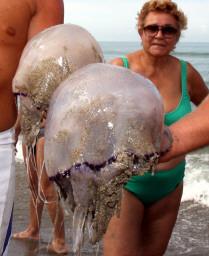Italy's southern Tyrrhenian coast has been invaded by jellyfish just as bathers are taking their first dip of the season, experts warned on Monday.
The Pelagia noctiluca jellyfish - also known as the mauve stinger - has been sighted on the beaches of Campania, western Calabria, northern Sicily and the fashionable Aeolian islands.
''We're talking about hundreds of thousands of specimens, both along and off the coast,'' said Silvio Greco, scientific director at the Institute for Applied Marine Research (ICRAM).
''Fishermen's nets - even the dragnets - are full of them. The jellyfish are not just on the surface but are distributed through the entire depth of the sea. It's not a good start to the season,'' he added.
Sometimes referred to as the nightlight jellyfish because of its ability to emit a characteristic greenish glow in the dark, the Pelagia noctiluca is a pink-orange colour and grows to a width of 15 cm. Its tentacles can grow up to four metres long and its sting is extremely unpleasant.
Crowds of the same species already drifted into the small port of Portofino in Liguria at the beginning of April.
Jellyfish invasions were once considered a cyclic phenomenon that occurred every 12 years, but since 2003 they have arrived in their hundreds of thousands almost every year.
There was a major occurrence of the Pelagia noctiluca in the summer of 2006 which stretched as far north as the northern region of Liguria and the city of Trieste at the top of the Adriatic.
At the time, experts said a heat wave and rising sea temperatures caused by climate change were factors behind the phenomenon.
Last year summer bathers were spared the stingers, as the jellyfish waited until September to make an off-season assault on the southwestern coasts, mainly affecting Calabria and Basilicata.
The late appearance alarmed experts, who again blamed climate change for upsetting the environmental balance of the ocean, with waters failing to cool down in autumn.
Greco said this year's invasion confirmed the pattern and pointed to alterations in the food chain.
''This is confirmation that something is going wrong in the marine ecosystem,'' he said.
''The jellyfish are feeding on fish larvae, and that's also going to have serious consequences for the fish,'' he added.









